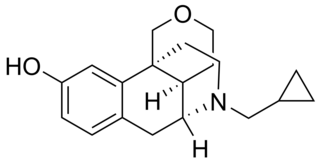Aromatic compounds are those chemical compounds that contain one or more rings with pi electrons delocalized all the way around them. In contrast to compounds that exhibit aromaticity, aliphatic compounds lack this delocalization. The term "aromatic" was assigned before the physical mechanism determining aromaticity was discovered, and referred simply to the fact that many such compounds have a sweet or pleasant odour; however, not all aromatic compounds have a sweet odour, and not all compounds with a sweet odour are aromatic. Aromatic hydrocarbons, or arenes, are aromatic organic compounds containing solely carbon and hydrogen atoms. The configuration of six carbon atoms in aromatic compounds is called a "benzene ring", after the simple aromatic compound benzene, or a phenyl group when part of a larger compound.

A heterocyclic compound or ring structure is a cyclic compound that has atoms of at least two different elements as members of its ring(s). Heterocyclic chemistry is the branch of organic chemistry dealing with the synthesis, properties, and applications of these heterocycles.

A cyclic compound is a term for a compound in the field of chemistry in which one or more series of atoms in the compound is connected to form a ring. Rings may vary in size from three to many atoms, and include examples where all the atoms are carbon, none of the atoms are carbon, or where both carbon and non-carbon atoms are present. Depending on the ring size, the bond order of the individual links between ring atoms, and their arrangements within the rings, carbocyclic and heterocyclic compounds may be aromatic or non-aromatic, in the latter case, they may vary from being fully saturated to having varying numbers of multiple bonds between the ring atoms. Because of the tremendous diversity allowed, in combination, by the valences of common atoms and their ability to form rings, the number of possible cyclic structures, even of small size numbers in the many billions.

Cyclazocine is a mixed opioid agonist/antagonist related to dezocine, pentazocine and phenazocine. This family of opioid drugs is called the benzomorphans or benzazocines. It is a KOR agonist and MOR partial agonist, and also has high affinity for the DOR.

Metazocine is an opioid analgesic related to pentazocine. While metazocine has significant analgesic effects, mediated through a mixed agonist–antagonist action at the mu opioid receptor, its clinical use is limited by dysphoric and hallucinogenic effects which are most likely caused by activity at kappa opioid receptors and/or sigma receptors.

Phenazocine is an opioid analgesic drug, which is related to pentazocine and has a similar profile of effects.

Alazocine, also known more commonly as N-allylnormetazocine (NANM), is a synthetic opioid analgesic of the benzomorphan family related to metazocine, which was never marketed. In addition to its opioid activity, the drug is a sigma receptor agonist, and has been used widely in scientific research in studies of this receptor. Alazocine is described as a potent analgesic, psychotomimetic or hallucinogen, and morphine or opioid antagonist. Moreover, one of its enantiomers was the first compound that was found to selectively label the σ1 receptor, and led to the discovery and characterization of the receptor.

Morphan is a chemical compound.

Bremazocine is a κ-opioid receptor agonist related to pentazocine. It has potent and long-lasting analgesic and diuretic effects. It has 200 times the activity of morphine, but appears to have no addictive properties and does not depress breathing. The crystal structure of bremazocine was determined in 1984

Azocine is a heterocyclic organic compound with the molecular formula C7H7N. It consists of an unsaturated eight-membered ring having seven carbon atoms, one nitrogen atom and four double bonds.

Azocane is a heterocyclic organic compound with the molecular formula C7H15N. It consists of a saturated eight-membered ring having seven carbon atoms and one nitrogen atom attached to a single hydrogen atom. The fully unsaturated analog of azocane is azocine.

Doxpicomine is a mild opioid analgesic drug. The drug acts as a mu-opioid receptor agonist. It is of fairly low potency, with a 400 mg dose of doxpicomine approximately equivalent in pain-killing effect to 8 mg morphine or 100 mg pethidine. It has been used as a lead compound to derive further analogues, although all compounds in this family are comparatively weak mu agonists.

Benzomorphan is a chemical compound that is the base for a series of drugs which variably act on the opioid kappa and sigma receptors, including the following compounds:

Proxorphan (INN), also known as proxorphan tartate (USAN), is an opioid analgesic and antitussive drug of the morphinan family that was never marketed. It acts preferentially as a κ-opioid receptor partial agonist and to a lesser extent as a μ-opioid receptor partial agonist.

Volazocine is an opioid analgesic of the benzomorphan class which was never marketed.

Moxazocine (BL-4566) is an opioid analgesic of the benzomorphan family which was never marketed. It acts as a partial agonist or mixed agonist/antagonist of the opioid receptors and binds preferentially to the κ-opioid receptor. Despite its failure to reach the market, clinical studies demonstrated moxazocine to be approximately 10x as potent by weight as morphine as an analgesic.

Butinazocine (INN) is an opioid analgesic of the benzomorphan family which was never marketed.

Fluorophen, or fluorofen, is a fluorinated analogue of phenazocine, an opioid drug of the benzomorphan group, which was developed as a radioligand for the purpose of labeling opioid receptors during PET scans. Unlike most other benzomorphan derivatives, fluorophen acts as a full agonist of the opioid receptors with preferential affinity for the μ-opioid receptor, similar but slightly lower affinity for the δ-opioid receptor, and very low affinity for the κ-opioid receptor.

Ethylketazocine (WIN-35,197-2), is an opioid drug of the benzomorphan family which has been used extensively in scientific research in the last few decades as a tool to aid in the study of the κ-opioid receptor. However, due to its relatively poor selectivity for the κ-opioid receptor over the μ- and δ-opioid receptors, as well as its relatively poor intrinsic activity at all sites, it has been mostly replaced in recent times by newer and more potent and selective compounds like U-50,488 and ICI-199,441.

Gemazocine (R-15,497), also known as cyclogemine, is a non-selective opioid antagonist of the benzomorphan class. It may have partial agonist properties at some of the opioid receptors, such as at the kappa receptor, but seems to be generally antagonistic in its actions.





















